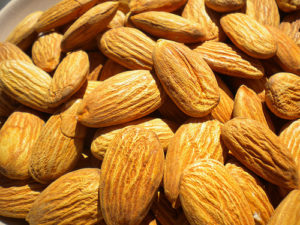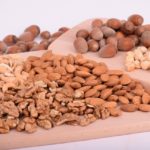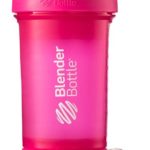How To Choose The Best Blender For Making Nut Butter
Nuts are difficult to blend up into smooth, delicious nut butter if you do not have the right blender. You will end up with a chunky mess. There is a fine line between the amazing fresh nut butter that you find in a Whole Foods or Moms Organic, and something that is a gloppy mess that you create in a substandard blender.
The issue that you have to look at is that not all blenders are designed to handle the same foods. Some blenders (such as the bullet blenders) are great for making simple fruit smoothies or handling protein shakes with berries. It’s a bit tricky to make nut butter, especially in quantity, when you are working with a smaller style blender such as the bullet style. What you’re going to end up doing is making a small batch and then having to add more nuts and make another small batch. This is time consuming. It’s for the same reason that you don’t tend to read recipes online which call for people to make falafal in a blender.
You will want a blender that is:
- Large Enough
- Has A Strong Enough Blending Motor
- Is Easy To Clean
Here’s my number one pick. Read more reviews online about this blender.
As a general rule, you’ll want to avoid any lower end blender if you are planning on making nut butter. The motors in these cheap blenders are simply not suited to making nut butter.
The Best Blender For Making Nut Butter For People On A Budget
This small ninja is perfect for people who want to blend nut butter, but don’t want a big blender.
The Ninja Blender is going to be your best option when you’re on a budget. While the VitaMix is the all purpose best blender, this model by Ninja certainly does the job. Plus it’s way cheaper. So, if you don’t have the money to spend on an expensive blender. This one’s perfect.
What’s Better For Making Nut Butter: Food Processor or Blender
You can definitely use a food processor to blend up nuts into nut butter, but even then you have to buy a good brand of food processor. The cheaper ones are substandard and you will end up with nuts that are not blender (a really chunky nut butter that’s a far cry from the “crunchy”). Large food processors made by good companies such as Cuisinart are good at making nut butter, but you have to make a decent amount of nut butter. Plus, if you haven’t already brought a food processor, and you’re not someone who will need them for other cooking needs (making pie dough, or scalloped potatoes, etc…) then you are probably best off buying a blender.
Blenders are quieter than the really good food processors. If you have the space in your kitchen, it’s a good idea to have both, but if you are tight on space and are not planning on making ground meats, and other things, then a blender will work just as well.
If you have a good food processor, then go ahead and use it. But if you don’t want to buy a food processor since you might also want to make smoothies (something you can’t do with a food processor) then you will want to make sure you choose a blender that is capable of making smooth nut butters.
A lot of things you can make with a food processor you can also make with a blender, but the opposite is not true. So, for this reason I suggest getting a really good blender. You will be able to make not just fruit and green smoothies, but you’ll also be able to make nut butters, falafel, hummus, gazpacho, and a ton of other delicious and healthy foods.
Why Blend Nuts?
Why not? While that’s a glib answer, it’s the truth. There are so many reasons to blend up your own nuts into healthy nut butter that it would be silly not to. Here’s just some of the many reasons:
-
Healthier Than Store Brought Nuts
When you blend up your own nuts, you know just exactly what you are putting into them. You don’t have to be worried about any additives such as oils that are unhealthy or too much salt, or preserving chemicals. Even if you have brought the “organic” and healthy nuts from expensive brands that you see at Whole Foods, Trader Joes, and other stores, you still don’t know the quality of the nuts. For instance, does your nut butter have mold? If you don’t see the nuts that are being blended up into nut butter, then you don’t know. And this can be a major problem. Peanuts, for instance, have a fungus called aflatoxin that has been linked to cancer.
-
Cheaper Than Store Brought Nut Butter
A huge consideration is the cost of nut butters, especially if you are going to be making healthy nut butters such as almond, cashew, macadamia nuts or other non-peanut butters. When you buy the whole nuts in bulk and then blend them up, the cost per serving is so much more affordable than if you were to buy it premade.
-
Nutrient Quality Is Superior In Freshly Blender Nut Butter
Anytime you have the option of having fresh food compared to pre-made food, you need to opt for the fresh food. And this is no different when it comes to nuts. You might think that its only an issue with juices, but think about what happens when you blend up nuts into nut butter. You are turning a whole food that has a hard consistency (the almond, pecan, walnut, whatever) into something that has the oils separated out. Look at some of the natural nut butters and how the oil pools on top. Oil can turn rancid or lose it’s benefits (as well as omega fatty acids, one of the most healthy parts of fresh nut butter) can also lose their potency when exposed to the air for too long.
Are Some Nuts Better To Blend Than Others?
Simply put, yes. Some of nuts are much healthier than others. In general, peanuts are the least beneficial of all nuts. That is not to say that peanuts are not healthy, they just are not super foods. Almonds and walnuts are generally accepted to be the most health nuts. Cashews, pecans, and macadamia nuts are also healthy. Here is a breakdown of the different nuts and their associated health benefits:
Walnuts and Almonds (Super Foods)

The two most commonly praised nuts are walnuts and almonds. There are countless studies on the topics (this long term study links an increase in nut consumption to heart disease). While it’s long been know that nuts are cardio protective, there are also studies that show that an increase in nut consumption has been shown to have neuroprotective qualities (that is they can help prevent Alzheimers and dementia).
This is generally accepted to be because almonds and walnuts have the best sources of Omega Fatty Acids, as well as anti-oxidents and minerals and vitamins (almonds, for instance, have a great nutrient profile and are a fantastic source of Vitamin E). Walnuts give you more Omega 3’s (the powerful heart and brain protective fatty acids) and almonds provide you with a whole food source of the antioxidant vitamin E.
I tried buying almond butter, but found that the consistency wasn’t the best. Oftentimes the store brought almond butters are a bit think at the bottom and more oily on top. This is why it’s a good idea to buy freshly ground almond butter (but that can get expensive after a while). Walnut butter is even rarer than almond butter, so you will likely not even find it for sale at most places in a jar.
When you are going to blend up walnuts, you can simply place the raw walnuts into the blender and mix up to a desired consistency. When it comes to blending up almonds you have two options. First, you can can pre-soak the almonds or, secondly, you blend them up raw/roasted. If you pre-soak the almonds then they will blend up easier. Pre-soaking almonds makes them softer and there is also some discussion in the scientific community about the benefits of soaking almonds (some nutritionist believe this makes them easier to digest). However, the taste will differ slightly if you soak almonds, so before making a huge batch of almond butter with soaked almonds, test them out to see if you like them. In addition to being easier to blend, soaked almonds also have more health benefits.
Peanuts
There tends to be a bias against peanuts. That’s understandable because peanuts are technically not nuts, they are legumes. And even though they are not “nuts” to say, they still have some benefits. For instance, one of the most heart healthy nutrients out there (Co-Q10) is difficult to obtain in food. Peanuts in particular are one of the foods that have a decent amount of Coenzyme Q-10. Several studies have shown the efficacy of peanuts and co-q 10.
So, while peanuts are not technically nuts, they certainly have some benefits. In addition to the CO-Q 10, peanuts are an excellent source of protein. Protein in nuts is one of the major reasons that you see them on the menus of bodybuilders.
The reason that you should be blending up your own nut butter is that peanuts, while healthy, are often times not healthy when you buy it in the store. For instance, you might have heard about an aflatoxin that some peanuts have which can cause cancer. This sort of moldy peanut is something that you might not be aware of if you’re buying low grade peanuts. However, if you’re buying good organic roasted peanuts, you will get a much healthier and safer peanut product that you can turn into a healthy nut butter.
Peanut butter in particular is one of the best nut butters to make at home. When it comes to buying peanut butter, it’s a potential landmine of malnutrients such as sugar, high fructose corn syrup, and other nasties such as hydrogenated oils. Really good organic peanut butter made with freshly roasted peanuts is rare, and it’s expensive. It’s actually so prohibitively expensive that even making a jars worth every month or so will pay for the blender over the course of a year.
Consider buying a jar or organic peanut butter once a month from a health food store? V.S. blending up your own peanuts that you’ve purchased online with your own blender? The cost of the blender recoups itself within a year.
Should You Use A Blender or Juicer For Making Nut Butter
In general, it’s best to use a blender to make nut butters. The blender will allow you to have much more control over the texture. There are some juicers that you can use to make nut butters. These juicers (the Omega cold press auger juicer) for instance, does have an attachment that allows you to make nut butters. The issue with using a cold press juicer to make nut butter is that there is less control over the texture. With a blender you will be able to make a rough or “crunchy” nut butter, or a smooth nut butter.
I recommend a blender, unless you’re planning on making juices (especially things such as celery juice, cabbage juice, or leafy green juice).
Not all blenders will do!
It’s important to note that not all blenders are designed to properly blend up nut butters. If you use a blender that is adequate to blend up a nice fruit smoothie or milkshake is not going to necessarily be able to handle blending up almonds or other hard nuts.
Blenders that don’t have a strong motor (such as the inexpensive bullet style blenders) won’t blend up the nuts. Trust me, I tried making peanut butter on more than a few occasions with a bullet blender and the results were less than stellar. And you don’t want to even attempt making almond butter in an inexpensive blender since almonds are so hard.
You want something such as the Ninja Blender or the Vitamix. These are the top of the line blenders and both allow you to create a smooth or crunchy nut butter. It’s especially beneficial for when you’re blending up the hard nuts.
If you are buying a blender and plan on making nut butters eventually, then make sure to choose either a Ninja or a Vitamix. Both of these are capable of blending up nuts into a smooth butters. I’d suggest steering clear of the cheaper blenders (the ones that you see for 30 or so dollar such as Hamilton Beach). While they are great with simpler tasks, they really don’t cut it when it comes to making almond butters or any nut butter for that instance.
My personal picks are these two blenders (I personally own the Ninja, but Vitamix is certainly a perfect option).
Vitamix Blender (blend nuts with no problems)
Vitamix is the gold standard when it comes to blenders, and it’s certainly going to come out on top (or at the near top) of any list of the best blenders for making nut butters (or really any sort of best blender article, which is why I mentioned them so often).
The advantage to using the Vitaminx Blender is that you won’t have to add any liquid or Oil (as long as you don’t over pack the blender jar, and use the plunder to make sure the nuts are all evenly dispersed).
The photo at left shows the sort of nut butter you can make with the VitaMix.
Not much to say about this blender aside from the fact that it’s simply the best option for anyone serious about:
- smoothies
- soups
- nut butters
- anything!
Ninja Blender (softer price point and assistance required)
If the price point on the Vitamix is a bit high for you, and you’re not looking to make that commitment yet, then I highly recommend the Ninja (it’s my current personal blender and the one I’ve used for all my blending purposes). It has all of the desired features in a blender for nut butters (a strong motor, a durable blade, and a large jar design).
There are several Ninja blenders on the market, but if you are planning on making nut butter, I do think it’s prudent to choose one that has a strong motor. This is why I suggest the strongest Ninja on the market (the one with the best motor).
It’s not really a brand that makes blenders designed to make nut butter, but it can work. What I suggest is adding something such as coconut oil (choose an extra virgin cold pressed brand of coconut oil) to aid in the process. This will help the blender make a much more smooth nut butter without risking burning our motor.
Even if you watch Youtube videos that show people dry blending almonds or peanuts with their Ninja blender, you are best advice is to add a bit of a healthy oil (a saturated fatty oil, actually healthy) is advised to prevent rancidity. You can get away with blending peanuts in your Ninja without worrying about the motor as long as you don’t overload.
I actually like this blender quite a bit, but unless you’re very disciplined about how your blend up your nuts, you do risk burning out the motor. It requires a lot of stop and starting if you’re doing a 100 percent nut mix, or the use of oil. If you’re creative, then that’s not a problem since flavoring nuts with coconut oil can actually improve the taste and health benefits (coconut oil has MCT (medium chain triglycerides). But if you want a simple nut recipe that only has nuts and salt, then I’d honestly opt for the Vita Mix.
Size Does Matter When It Comes To Blending Nut Butter
Another reason that I don’t suggest picking a bullet blender (even if you get one of the more expensive ones that have stronger motors) is that they are not large enough. You want a blender with a jar style design, not one of those small bullet blenders. The smaller the blender, the more lilkely it is that you’ll burn out the motor. The smaller blenders are fine for fruit smoothies, protien shakes, or the like, but if you’re making nut butters, then steer clear.
Easy To Remove The Nut Butter
You want to be able to easily remove the nut butter. Honestly, the two blenders reviewed above come in neck to neck. The type of blenders you want to avoid are the bullet blenders.
What To Do With All That Healthy Nut Butter: Storage Options
When you do end up making your nut butter, you’re going to want somewhere to store it. You want to avoid BPA and other plastic containers that leach toxic chemicals. Many people tend to think that the only issue with plastic is BPA and acidic foods such as tomatoes and citrus. However, there have been many researchers that have found and documented that even non-acidic foods (even bland tap water!) have the ability to leach the chemicals into your food and drink. For that reason, I always suggest glass, stainless steel, or a plastic that is free from BPA.
For instance:
BPA Free Non-Glass Storage Containers For Nut Butter
I own these and have used the from everything from fresh peanut butter, pasta sauces, to pineapple.
Glass Containers To Store Your Nut Butter
I personally like these the best if you’re not going to be taking your nut butter to and from work (or location 1 to 2). The benefit is that they are easy to fill up (they don’t have a narrow mouth like some smaller jars that people use). While it’s unconventional, they are really easier to fill up with fresh nut butter and also easy to clean. Plus, all you need to do is use a spoon to empty them out.
Classic Alternatives To Plastic Nut Butter Containers
So if you do like the jar design of a nut butter container, then what I suggest for you if you’re looking to store your own peanut (or almond, walnut, macadamia nut butter) is to get a classic Mason jar. These are perfect and easy to fill. I do suggest that you swap out the metal lid that they have with a good plastic lid. Here’s my personal fav.
Related Posts

Hi Everyone!
Jenny O’Brien here. Nutritionist & personal trainer. Just your average vegetarian and smoothie fanatic!
If you have any questions, or you’d like me to cover a particular topic, drop me a line and let me know!
Thanks!






